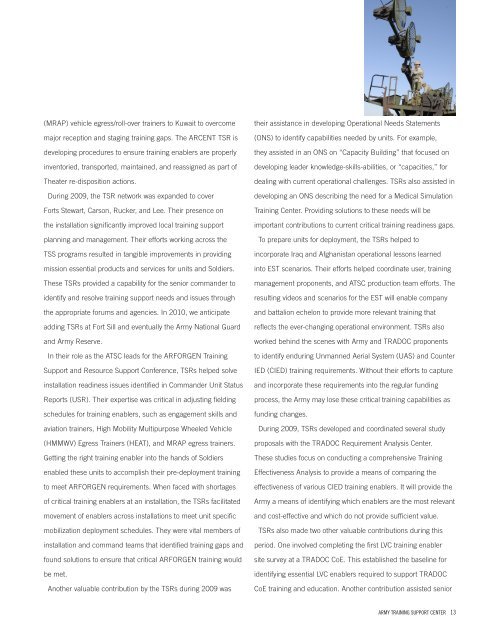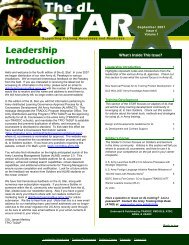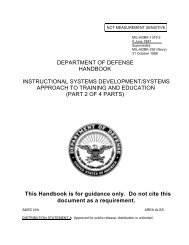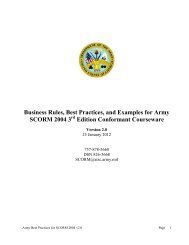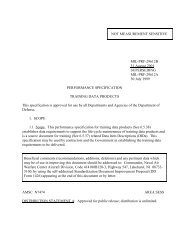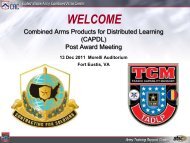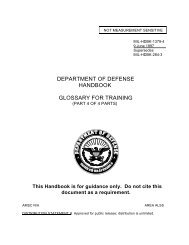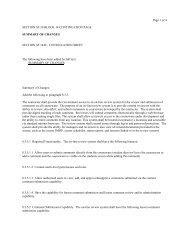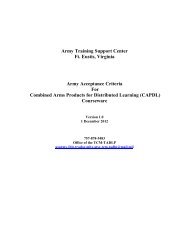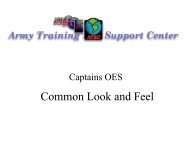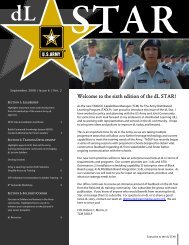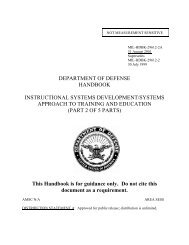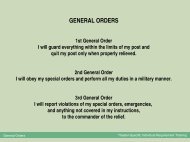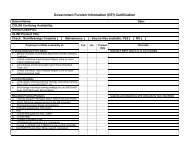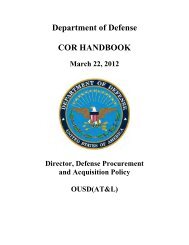annual report 2008 annual report 2009 - U. S. Army Training ...
annual report 2008 annual report 2009 - U. S. Army Training ...
annual report 2008 annual report 2009 - U. S. Army Training ...
You also want an ePaper? Increase the reach of your titles
YUMPU automatically turns print PDFs into web optimized ePapers that Google loves.
(MRAP) vehicle egress/roll-over trainers to Kuwait to overcome<br />
major reception and staging training gaps. The ARCENT TSR is<br />
developing procedures to ensure training enablers are properly<br />
inventoried, transported, maintained, and reassigned as part of<br />
Theater re-disposition actions.<br />
During <strong>2009</strong>, the TSR network was expanded to cover<br />
Forts Stewart, Carson, Rucker, and Lee. Their presence on<br />
the installation significantly improved local training support<br />
planning and management. Their efforts working across the<br />
TSS programs resulted in tangible improvements in providing<br />
mission essential products and services for units and Soldiers.<br />
These TSRs provided a capability for the senior commander to<br />
identify and resolve training support needs and issues through<br />
the appropriate forums and agencies. In 2010, we anticipate<br />
adding TSRs at Fort Sill and eventually the <strong>Army</strong> National Guard<br />
and <strong>Army</strong> Reserve.<br />
In their role as the ATSC leads for the ARFORGEN <strong>Training</strong><br />
Support and Resource Support Conference, TSRs helped solve<br />
installation readiness issues identified in Commander Unit Status<br />
Reports (USR). Their expertise was critical in adjusting fielding<br />
schedules for training enablers, such as engagement skills and<br />
aviation trainers, High Mobility Multipurpose Wheeled Vehicle<br />
(HMMWV) Egress Trainers (HEAT), and MRAP egress trainers.<br />
Getting the right training enabler into the hands of Soldiers<br />
enabled these units to accomplish their pre-deployment training<br />
to meet ARFORGEN requirements. When faced with shortages<br />
of critical training enablers at an installation, the TSRs facilitated<br />
movement of enablers across installations to meet unit specific<br />
mobilization deployment schedules. They were vital members of<br />
installation and command teams that identified training gaps and<br />
found solutions to ensure that critical ARFORGEN training would<br />
be met.<br />
Another valuable contribution by the TSRs during <strong>2009</strong> was<br />
their assistance in developing Operational Needs Statements<br />
(ONS) to identify capabilities needed by units. For example,<br />
they assisted in an ONS on “Capacity Building” that focused on<br />
developing leader knowledge-skills-abilities, or “capacities,” for<br />
dealing with current operational challenges. TSRs also assisted in<br />
developing an ONS describing the need for a Medical Simulation<br />
<strong>Training</strong> Center. Providing solutions to these needs will be<br />
important contributions to current critical training readiness gaps.<br />
To prepare units for deployment, the TSRs helped to<br />
incorporate Iraq and Afghanistan operational lessons learned<br />
into EST scenarios. Their efforts helped coordinate user, training<br />
management proponents, and ATSC production team efforts. The<br />
resulting videos and scenarios for the EST will enable company<br />
and battalion echelon to provide more relevant training that<br />
reflects the ever-changing operational environment. TSRs also<br />
worked behind the scenes with <strong>Army</strong> and TRADOC proponents<br />
to identify enduring Unmanned Aerial System (UAS) and Counter<br />
IED (CIED) training requirements. Without their efforts to capture<br />
and incorporate these requirements into the regular funding<br />
process, the <strong>Army</strong> may lose these critical training capabilities as<br />
funding changes.<br />
During <strong>2009</strong>, TSRs developed and coordinated several study<br />
proposals with the TRADOC Requirement Analysis Center.<br />
These studies focus on conducting a comprehensive <strong>Training</strong><br />
Effectiveness Analysis to provide a means of comparing the<br />
effectiveness of various CIED training enablers. It will provide the<br />
<strong>Army</strong> a means of identifying which enablers are the most relevant<br />
and cost-effective and which do not provide sufficient value.<br />
TSRs also made two other valuable contributions during this<br />
period. One involved completing the first LVC training enabler<br />
site survey at a TRADOC CoE. This established the baseline for<br />
identifying essential LVC enablers required to support TRADOC<br />
CoE training and education. Another contribution assisted senior<br />
ARMY TRAINING SUPPORT CENTER 13


